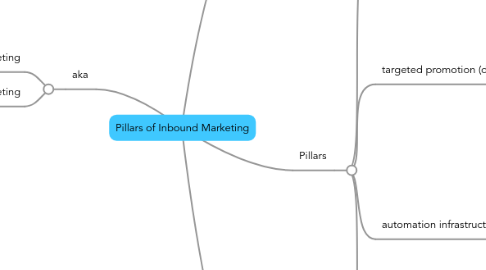
1. aka
1.1. engagement marketing
1.2. content marketing
2. Process
2.1. brand
2.1.1. target
2.1.2. frame of reference
2.1.3. unique selling proposition
2.1.4. reasons to believe
2.2. target
2.2.1. develop buyer personas
2.2.1.1. buyer attributes
2.2.1.1.1. roles, titles
2.2.1.1.2. company size
2.2.1.1.3. industry
2.2.1.1.4. needs
2.2.1.1.5. frustrations
2.2.1.1.6. desires
2.2.1.1.7. motivations
2.2.1.1.8. goals
2.2.1.1.9. problems
2.2.1.1.10. communication channels
2.2.1.2. do i need more data?
2.2.1.2.1. focus groups
2.2.1.2.2. surveys
2.2.1.2.3. observed behavior (online or offline)
2.2.1.2.4. web analytics
2.2.2. align messaging with buyers
2.2.2.1. capability mapping
2.2.2.2. framing questions
2.2.2.3. diagnostic questions
2.2.2.4. buyer-vision questions
2.2.2.5. solution summary
2.2.2.6. relevant proof points (success story)
2.3. execute
2.3.1. build a messaging architecture
2.3.2. ongoing
2.3.2.1. get found
2.3.2.1.1. strategize
2.3.2.1.2. create
2.3.2.1.3. optimize
2.3.2.1.4. promote
2.3.2.2. convert
2.3.2.2.1. visitors to leads
2.3.2.2.2. leads to customers
2.3.2.3. close the loop
2.3.2.4. adapt
2.3.2.4.1. page optimization
2.3.2.4.2. keyword performance
2.3.2.4.3. persona refinement
2.3.2.4.4. budget re-allocation
2.4. stumbling blocks
2.4.1. resource allocation and commitment
2.4.1.1. where will content come from?
2.4.1.2. how much will content cost?
2.4.1.3. who will train my staff?
2.4.2. website design, development, deployment
2.4.2.1. custom platform
2.4.2.2. hybrid
2.4.2.3. hosted solution
3. Pillars
3.1. compelling content
3.1.1. goal-oriented, purpose driven
3.1.2. relevant, substantive
3.1.2.1. a result of effective buyer personas
3.1.3. exclusive
3.1.4. brand building or affirming
3.1.4.1. clarifies positioning
3.1.4.2. communicates uniqueness
3.1.4.3. consistent with or evolution of identity
3.1.5. stylistically appropriate
3.2. targeted promotion (driving traffic)
3.2.1. search
3.2.1.1. organic search
3.2.1.2. PPC
3.2.2. social media
3.2.3. email
3.2.4. offline
3.3. automation infrastructure
3.3.1. publishing system (cms)
3.3.1.1. website
3.3.1.1.1. information design
3.3.1.1.2. visual design
3.3.1.1.3. stack
3.3.1.1.4. programming
3.3.1.1.5. support
3.3.1.2. other channels
3.3.2. lead capture
3.3.2.1. landing page
3.3.2.2. email list integration
3.3.3. lead management
3.3.3.1. scoring
3.3.3.2. nurturing
3.3.3.2.1. email
3.3.3.2.2. lead tracking
3.3.3.2.3. CRM integration
3.3.3.3. disposition
3.3.4. intelligence
3.3.4.1. website activity
3.3.4.2. social media monitoring
3.3.5. alerts
3.4. continuous improvement
3.4.1. what
3.4.1.1. building/evolving the brand
3.4.1.1.1. better service
3.4.1.1.2. more services
3.4.1.2. building/evolving the buyer persona
3.4.1.2.1. more sales
3.4.1.2.2. more profitable sales
3.4.1.3. improving productivity
3.4.1.3.1. lower marketing costs
3.4.1.3.2. generating more leads
3.4.2. how
3.4.2.1. feedback loops
3.4.2.1.1. surveys
3.4.2.1.2. brand monitoring
3.4.2.2. observed behavior
3.4.2.2.1. meaningful online metrics
3.4.2.2.2. offline
4. summary
4.1. get found
4.2. convert
4.2.1. visitor-to-lead
4.2.2. lead-to-customer
